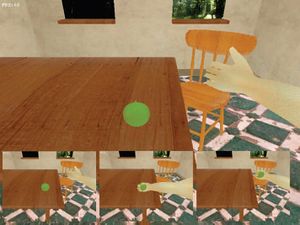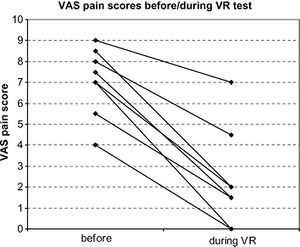Difference between revisions of "Serious games in therapy"
(Added everything in Serious VR games in therapy) |
(Added more subsections) |
||
| Line 2: | Line 2: | ||
== Psychiatric disorders == | == Psychiatric disorders == | ||
| + | === Phobia treatment === | ||
Especially in psychiatric disorders, VR gained a lot popularity in the last few years. Phobia rehabilitation is one of these application fields. Between 10 and 11 percent of the US population have a specific phobia[http://www.vrphobia.com/spiders.htm]. The example here will be "Arachnophobia" - the fear of spiders, which affects around 4% of the inhabitants of the USA. A phobia like that was treated with an exposure therapy until recently, but patients were obviously anxious about getting confronted with real spiders in therapy in the first place, which probably reduced the chance to even start one (See "Virtual Reality in neuroscience research and therapy" by Corey J. Bohil, Bradly Alicea and Frank A. Biocca). With virtual reality there's the possibility to challenge the phobia step by step by reducing the anxiety of the therapy as is, since the patient knows that the virtual spiders aren't real and won't be able to 'harm' them and they're able to quit this alternate reality at any point. | Especially in psychiatric disorders, VR gained a lot popularity in the last few years. Phobia rehabilitation is one of these application fields. Between 10 and 11 percent of the US population have a specific phobia[http://www.vrphobia.com/spiders.htm]. The example here will be "Arachnophobia" - the fear of spiders, which affects around 4% of the inhabitants of the USA. A phobia like that was treated with an exposure therapy until recently, but patients were obviously anxious about getting confronted with real spiders in therapy in the first place, which probably reduced the chance to even start one (See "Virtual Reality in neuroscience research and therapy" by Corey J. Bohil, Bradly Alicea and Frank A. Biocca). With virtual reality there's the possibility to challenge the phobia step by step by reducing the anxiety of the therapy as is, since the patient knows that the virtual spiders aren't real and won't be able to 'harm' them and they're able to quit this alternate reality at any point. | ||
| Line 8: | Line 9: | ||
In therapy, the patient is wearing VR-goggles and headphones. The treatment is done in different stages - the progress pace of these stages only depend on the patient. A stage consists of different maps and challenges. Inthe picture on the right, the player is confronted with a room filled with virtual spiders and is even getting approached by them. This is one of the final steps, since the patient is starting off with a closed jar containing a spider. The entire therapy lasts around 8 to 12 sessions[http://www.vrphobia.com/spiders.htm]. | In therapy, the patient is wearing VR-goggles and headphones. The treatment is done in different stages - the progress pace of these stages only depend on the patient. A stage consists of different maps and challenges. Inthe picture on the right, the player is confronted with a room filled with virtual spiders and is even getting approached by them. This is one of the final steps, since the patient is starting off with a closed jar containing a spider. The entire therapy lasts around 8 to 12 sessions[http://www.vrphobia.com/spiders.htm]. | ||
| + | === Fear conditioning === | ||
Another field of application is fear conditioning. Here, the patients are receiving a certain signal, which warns them from occurring danger. This is usually done to research how a patient is reacting on such a stimulus: is he feeling fear or rather is his heart rate or breath changing? | Another field of application is fear conditioning. Here, the patients are receiving a certain signal, which warns them from occurring danger. This is usually done to research how a patient is reacting on such a stimulus: is he feeling fear or rather is his heart rate or breath changing? | ||
"A number of theorists have argued that conditioned fear coincides substantially with the mechanisms, both functional and neural, of clinical anxiety disorders"[https://en.wikipedia.org/wiki/Fear_conditioning]. | "A number of theorists have argued that conditioned fear coincides substantially with the mechanisms, both functional and neural, of clinical anxiety disorders"[https://en.wikipedia.org/wiki/Fear_conditioning]. | ||
| Line 15: | Line 17: | ||
In the case of the example here, the researchers used a CAVE-like[https://en.wikipedia.org/wiki/Cave_automatic_virtual_environment] environment called "DiVE" (Duke's Immersive Virtual Environment) (See "Human Fear Conditioning Conducted in Full Immersion 3-Dimensional Virtual Reality" from Nicole C. Huff, David J. Zielinski, Matthew E. Fecteau, Rachael Brady and Kevin S. LaBar). As the picture on the right shows, the player is sitting inside four walls and wearing stereoscopic glasses. The world is projected onto the walls. Also, there are controllers for the movement of the own avatar. And more important: A wrist band, which lets the researchers induce an electrical stimulus. This stimulus is used right before a dangerous animal appears in front of the player. This is either a snake or a spider - the kind of induced stimulus depends on the appearing animal. | In the case of the example here, the researchers used a CAVE-like[https://en.wikipedia.org/wiki/Cave_automatic_virtual_environment] environment called "DiVE" (Duke's Immersive Virtual Environment) (See "Human Fear Conditioning Conducted in Full Immersion 3-Dimensional Virtual Reality" from Nicole C. Huff, David J. Zielinski, Matthew E. Fecteau, Rachael Brady and Kevin S. LaBar). As the picture on the right shows, the player is sitting inside four walls and wearing stereoscopic glasses. The world is projected onto the walls. Also, there are controllers for the movement of the own avatar. And more important: A wrist band, which lets the researchers induce an electrical stimulus. This stimulus is used right before a dangerous animal appears in front of the player. This is either a snake or a spider - the kind of induced stimulus depends on the appearing animal. | ||
| + | === Anxiety disorders === | ||
Also, anxiety disorders in general can be treated or improved by meditation[http://www.chopra.com/articles/how-meditation-can-help-anxiety]. The goal there is that the patients are relaxing their minds from 'overthinking' situations. Situations, such as social interactions or other everyday things like "Did I lock the door, when I left?" etc. Meditation helps to unfocus from these kind of thoughts. | Also, anxiety disorders in general can be treated or improved by meditation[http://www.chopra.com/articles/how-meditation-can-help-anxiety]. The goal there is that the patients are relaxing their minds from 'overthinking' situations. Situations, such as social interactions or other everyday things like "Did I lock the door, when I left?" etc. Meditation helps to unfocus from these kind of thoughts. | ||
| Line 21: | Line 24: | ||
The game is meant to simplify the process of starting to meditate for a patient. It probably improves or speeds up the first steps, since there is an actual distraction and the player is able to 'flee' into another calming world. | The game is meant to simplify the process of starting to meditate for a patient. It probably improves or speeds up the first steps, since there is an actual distraction and the player is able to 'flee' into another calming world. | ||
| + | === Brain damage === | ||
Brain damage also counts into psychiatric disorders. In that case, the patients often are able to do a movement therapy at home. There's already lots of serious games like "MOVER", where the player has to recreate a shape or position of his body as he is seeing on a screen[https://phys.org/news/2015-09-mover-technology-therapy-brain-injury.html]. These kind of games could also be really easily redone as a VR-version, where a camera of a computer tracks the patient's position and displays it in the virtual reality compared to the expected position. | Brain damage also counts into psychiatric disorders. In that case, the patients often are able to do a movement therapy at home. There's already lots of serious games like "MOVER", where the player has to recreate a shape or position of his body as he is seeing on a screen[https://phys.org/news/2015-09-mover-technology-therapy-brain-injury.html]. These kind of games could also be really easily redone as a VR-version, where a camera of a computer tracks the patient's position and displays it in the virtual reality compared to the expected position. | ||
== Pain remediation == | == Pain remediation == | ||
| + | === phantom limb pain === | ||
Patients which have lost a limb often struggle of phantom limb pain. That means that they're feeling a pain in the missing limb, just by unconsciously knowing or seeing that it is not there anymore. In the past, this was treated with the mirror box device of Ramachandran[https://www.youtube.com/watch?v=fbzrPX_Urb4]: The patient inserts the opposite (functioning) limb into a box. In there the limb get's reflected by a mirror that way that it looks like that his missing limb is still there. By moving it, most patients feel an actual reduce of the phantom limb pain. | Patients which have lost a limb often struggle of phantom limb pain. That means that they're feeling a pain in the missing limb, just by unconsciously knowing or seeing that it is not there anymore. In the past, this was treated with the mirror box device of Ramachandran[https://www.youtube.com/watch?v=fbzrPX_Urb4]: The patient inserts the opposite (functioning) limb into a box. In there the limb get's reflected by a mirror that way that it looks like that his missing limb is still there. By moving it, most patients feel an actual reduce of the phantom limb pain. | ||
| Line 31: | Line 36: | ||
As seen in the Figure on the right most of the subjects of the experiment felt an actual reduction of their phantom limb pain by using this serious VR game (See "Exploratory findings with virtual reality for phantom limb pain; from stump motion to agency and analgesia" from Jonathan Cole, Simon Crowle, Greg Austwick and David Henderson Slater). This was a bigger reduction than from the distraction of the game only, according to the patients. | As seen in the Figure on the right most of the subjects of the experiment felt an actual reduction of their phantom limb pain by using this serious VR game (See "Exploratory findings with virtual reality for phantom limb pain; from stump motion to agency and analgesia" from Jonathan Cole, Simon Crowle, Greg Austwick and David Henderson Slater). This was a bigger reduction than from the distraction of the game only, according to the patients. | ||
| + | === Burn victims === | ||
[[File:Burn.jpg|thumb|An virtual arctic world to reduce a burn victim's pain.]] | [[File:Burn.jpg|thumb|An virtual arctic world to reduce a burn victim's pain.]] | ||
Burn victims also suffer from pain, which can be improved with the help of Virtual Reality. Especially when the bandages of the patients get changed they go through a lot of ache. Usually that gets treated by opioid pain medications - but it was found that a distraction with a VR-game is even more effective (See "Virtual Reality in neuroscience research and therapy" by Corey J. Bohil, Bradly Alicea and Frank A. Biocca). The game is really simple and only consists of a virtual environment, where the user can freely navigate through. But the crux of the matter is, that the virtual world is set in a cold scenery, which adds to the distraction alone. | Burn victims also suffer from pain, which can be improved with the help of Virtual Reality. Especially when the bandages of the patients get changed they go through a lot of ache. Usually that gets treated by opioid pain medications - but it was found that a distraction with a VR-game is even more effective (See "Virtual Reality in neuroscience research and therapy" by Corey J. Bohil, Bradly Alicea and Frank A. Biocca). The game is really simple and only consists of a virtual environment, where the user can freely navigate through. But the crux of the matter is, that the virtual world is set in a cold scenery, which adds to the distraction alone. | ||
Latest revision as of 18:55, 11 December 2017
Serious virtual reality games have successfully been applied in various fields of therapy. They are used to reduce a patient's suffering respectively improve one's condition. In the most cases of the following disorders, there were used different kinds of exposure therapies. But in the last few years, virtual reality became more easily available and even enabled a therapy at all in some cases, where no exposure therapy was possible.
Contents
Psychiatric disorders
Phobia treatment
Especially in psychiatric disorders, VR gained a lot popularity in the last few years. Phobia rehabilitation is one of these application fields. Between 10 and 11 percent of the US population have a specific phobia[1]. The example here will be "Arachnophobia" - the fear of spiders, which affects around 4% of the inhabitants of the USA. A phobia like that was treated with an exposure therapy until recently, but patients were obviously anxious about getting confronted with real spiders in therapy in the first place, which probably reduced the chance to even start one (See "Virtual Reality in neuroscience research and therapy" by Corey J. Bohil, Bradly Alicea and Frank A. Biocca). With virtual reality there's the possibility to challenge the phobia step by step by reducing the anxiety of the therapy as is, since the patient knows that the virtual spiders aren't real and won't be able to 'harm' them and they're able to quit this alternate reality at any point.
In therapy, the patient is wearing VR-goggles and headphones. The treatment is done in different stages - the progress pace of these stages only depend on the patient. A stage consists of different maps and challenges. Inthe picture on the right, the player is confronted with a room filled with virtual spiders and is even getting approached by them. This is one of the final steps, since the patient is starting off with a closed jar containing a spider. The entire therapy lasts around 8 to 12 sessions[2].
Fear conditioning
Another field of application is fear conditioning. Here, the patients are receiving a certain signal, which warns them from occurring danger. This is usually done to research how a patient is reacting on such a stimulus: is he feeling fear or rather is his heart rate or breath changing? "A number of theorists have argued that conditioned fear coincides substantially with the mechanisms, both functional and neural, of clinical anxiety disorders"[3].
In the case of the example here, the researchers used a CAVE-like[4] environment called "DiVE" (Duke's Immersive Virtual Environment) (See "Human Fear Conditioning Conducted in Full Immersion 3-Dimensional Virtual Reality" from Nicole C. Huff, David J. Zielinski, Matthew E. Fecteau, Rachael Brady and Kevin S. LaBar). As the picture on the right shows, the player is sitting inside four walls and wearing stereoscopic glasses. The world is projected onto the walls. Also, there are controllers for the movement of the own avatar. And more important: A wrist band, which lets the researchers induce an electrical stimulus. This stimulus is used right before a dangerous animal appears in front of the player. This is either a snake or a spider - the kind of induced stimulus depends on the appearing animal.
Anxiety disorders
Also, anxiety disorders in general can be treated or improved by meditation[5]. The goal there is that the patients are relaxing their minds from 'overthinking' situations. Situations, such as social interactions or other everyday things like "Did I lock the door, when I left?" etc. Meditation helps to unfocus from these kind of thoughts.
Owen Harris also struggled of an anxiety disorder and used meditation to treat it. He is a game designer and wanted to create himself a little game to simplify his meditation sessions. When the Oculus Rift first appeared, he started to work on an early version of "Deep VR" - a serious game for meditation[6]. The concept of the game is pretty simple: The player swims through a virtual marine world by using VR-goggles. Another controller for the virtual environment is attached to the player's stomach. It measures the diaphragm expansion in order to sense deep breathing to which the game reacts in different ways. For example, the brighter objects and streaks lighten up when the player inhales. The game is meant to simplify the process of starting to meditate for a patient. It probably improves or speeds up the first steps, since there is an actual distraction and the player is able to 'flee' into another calming world.
Brain damage
Brain damage also counts into psychiatric disorders. In that case, the patients often are able to do a movement therapy at home. There's already lots of serious games like "MOVER", where the player has to recreate a shape or position of his body as he is seeing on a screen[7]. These kind of games could also be really easily redone as a VR-version, where a camera of a computer tracks the patient's position and displays it in the virtual reality compared to the expected position.
Pain remediation
phantom limb pain
Patients which have lost a limb often struggle of phantom limb pain. That means that they're feeling a pain in the missing limb, just by unconsciously knowing or seeing that it is not there anymore. In the past, this was treated with the mirror box device of Ramachandran[8]: The patient inserts the opposite (functioning) limb into a box. In there the limb get's reflected by a mirror that way that it looks like that his missing limb is still there. By moving it, most patients feel an actual reduce of the phantom limb pain.
The modern treatment method is using the same concept. Here, the patient is wearing VR-goggles and sees a virtual environment including his avatar which shows him his (in reality) missing limb. The virtual limb is controlled by a motion capture of the patient's stump. In the picture on the right, a person lost its right arm and is able to pick up an apple from a table in the virtual world with its virtual arm. As seen in the Figure on the right most of the subjects of the experiment felt an actual reduction of their phantom limb pain by using this serious VR game (See "Exploratory findings with virtual reality for phantom limb pain; from stump motion to agency and analgesia" from Jonathan Cole, Simon Crowle, Greg Austwick and David Henderson Slater). This was a bigger reduction than from the distraction of the game only, according to the patients.
Burn victims
Burn victims also suffer from pain, which can be improved with the help of Virtual Reality. Especially when the bandages of the patients get changed they go through a lot of ache. Usually that gets treated by opioid pain medications - but it was found that a distraction with a VR-game is even more effective (See "Virtual Reality in neuroscience research and therapy" by Corey J. Bohil, Bradly Alicea and Frank A. Biocca). The game is really simple and only consists of a virtual environment, where the user can freely navigate through. But the crux of the matter is, that the virtual world is set in a cold scenery, which adds to the distraction alone.
Neurorehabilitation
Stroke victims often suffer from lots of brain damage and need to go through longer rehabilitation therapies to retrain their body-functions. This is usually done with a physiotherapist, which tells the patient what kind of exercises he has to do. Such as what position he has to go in or which actions he has to do to train the function of his arms etc. But this task can also be taken on by a serious VR game. The game offers different exercises and guides through them playful[9]. For example, the patient has to train his leg function - in that case, the game wants him to kick a virtual football into a goal in different angles etc. This is done by a Kinect-camera recording and tracking the player's position and movements.








